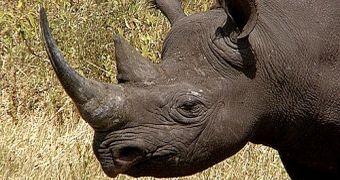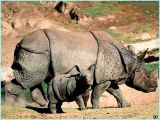1.We associate rhinoceroses with the African savannas and the forests of southern Asia. But rhinoceroses appeared in fact in North America 54 Ma ago, from a common ancestor with the horses and tapirs. In time, rhinos diversified in many genera and species. Baluchitherium, which lived 30 Ma ago in Central Asia in a time when Himalaya did not exist, was the largest ever land mammal: 5.2 m (18 ft) tall, 8.2 m (27 ft) long and 15 tons heavy. This rhinoceros was devoid of horns. Today's white African rhino can weigh up to 7,920 pounds (3,600 kg), 4.2 m (13.9 ft) in length and a shoulder height of 185 cm (73 in).
2.Rhinoceroses have 3 digits at each limb, partially wrapped in hooves. The tough, resistant skin has a thickness on the back up to 6 cm (2.4 in). In the Indian rhinoceros and Javan rhinoceros, it forms a kind of armor, made of horny plates. The only current rhinoceros having abundant body hair are the Sumatran rhinoceros. The woolly rhinoceros (Coelodonta antiquitatis), extinct at the end of the last Ice Age, had abundant hair like in musk oxen.
These animals have poor eyesight and cannot identify an immobile shape located at a distance of 10 m (33 ft). Instead, the olfaction and hearing are keen. Rhinoceros also are great amateurs of mud baths, which cool them down and protect them against the parasites and insect bites.
3."Rhinoceros" comes from Old Greek meaning literally "horned nose". The most obvious and distinguishing characteristic of a rhino is its large one or two horns above the nose. The white rhino has a fore large horn, 0.5-1.5 m (1.3-5 ft) long and a rear smaller horn, 0.2-0.6 m (0.6-2 ft) long.
Rhinoceros' horns are unique not only because of their position, but also because of their composition and structure, being made only of keratin. Horns of other mammals, like cattle, buffaloes, giraffes, antelopes, sheep, goats, gazelles or pronghorn, have a bony core covered by a sheath of keratin, the same substance found in nails, hair, wool, bird feathers, reptile scales, or in the outer layer of vertebrate skin.
Researchers believed that the horns are just clumps of agglutinated hair, as at the base they may be crumbling. But CT scans and microscopy have revealed that their structure resembles that of the hooves. The horn grows like nails, and in the African black rhino it can be 1.4 m (4 ft, 8 in) long, while in the case of the African white rhino, which doubles the black rhino in size, it can be even 2 m (6.6 ft) long. If the horn breaks, it grows back by 8 cm (3 in) per year.
Today, these damned horns have been the reason why rhinos die by human hand because many cultures price them for their supposed magical or medicinal qualities. In Malaysia, rhino horns are used against malaria, nausea, fever, heart conditions, dementia, toothache. Those medicines have of course the same effect as chewing your nails... Paradoxically, Africans do not regard rhino horns as aphrodisiacs, even if now only Africa delivers rhino horns to the black market.
Chinese traditional medicine has used rhino horns since the first century BC. Especially the freshly killed male horns are sought. Powdered horns were used against epidemics, for chasing demons and against poisoning.
Rhino horns are the most useless way of wasting money (a lot of it) and time to achieve nothing; its (illegal) usage in traditional Chinese medicine comes from the performances of the animal (rhino sex lasts from 30 minutes to more than one hour) and its large penis (on average 80 cm or 2.5 feet). People regarded the horn as a symbol of the sexual power of the rhino, perhaps because the horn could resemble an erect penis. For ignorant minds, that's enough to grind and ingest it to get the rhino's powers. Chewing nails is at least for free and does not kill such a superb beast like a rhino. In 1993, China banned the trade with rhino horns, but illegal trade is still made.
Even in the European medieval times, cups made of rhino horns were considered to annihilate poison.
In other cultures (like in Yemen or Oman), showing off djambia daggers with handles made of rhino horn and a blade resembling the rhino horn was a sign of health... Yemen people say nothing is better for the looks and resistance... The older handlers are more valued, as they get a translucence similar to amber. 40% of the traffic with rhino horns is made by the Yemen. In other times, djambia were worn only by the tribal chiefs, but today by everyone who can afford. Sanaa craftsmen can make 3 djambia from one rhino horn. African black rhinos have paid costly for this habit.
Sad ending for these odd and amazing beasts that survived so many geological eras just to end up like this. In the attempt to save the rhinos, many individuals in the African reserves had their horns removed, yet with no results. In 1990, the rhino horns were sold with $ 20,751 per kilogram (2.2 pounds) in Hong Kong, and with $ 23,810 per kg in Kuala Lumpur (Malaysia). And a whole horn weighs over 5 kg. That's why poachers consider that even what's left after the removal of the horn is worth a lot. In fact, two rhino species (woolly rhino and giant unicorn) from Eurasian steppes might have been wiped out by humans, and all current species are amongst the most endangered big animals.
4.One myth: is there a black and a white rhino in Africa? No. Both species are gray (with specific hues) but usually what you see is the color of the mud from the last mudbath (pigs are amateurs compared to rhinos in this practice that helps them cool down, chase away flies, eliminate skin parasites and... meet another rhino).
Their name comes from a mistranslation from Afrikaans (the Dutch variant spoken by the South African Boers): they called the animal "wyd" rhino (meaning "wide") because the animal, a grazer, has wide lips, while the black rhino, feeding on leaves and twigs, has a pointed mouth. The white rhino includes two races: the southern Ceratotherium simum simum from meridional Africa, and C.s.cottono, northern white rhinoceros, inhabiting a small area at the sources of the Nile River, in northeastern Uganda, southern Sudan and neighboring Zaire.
There is a widespread belief that the black rhino is much more aggressive than the white rhino, but in fact the white rhino too can be dangerous if provoked. Because rhinos have poor eyesight, they will attack anything they can hear and smell well, from butterfly-sized to train-sized objects. And despite the huge stature, black rhinos can run 55 km (34 mi) per hour and make rapid turns of 180'! White rhinos, which double them in size, can run at a speed of 40 km (25 mi) per hour.
5.Rhinos are solitary creatures. Mating occurs all year round, and males use their horns to battle for the right of mating. Mating can last over one hour (hence the myth that the horn is an aphrodisiac, besides the large size of the penis). A female can mate with several males, and a male with several females (this promiscuous system means that rhinos are polyandrous and polygynous at the same time).
Only the mother and the offspring live together, and their bond lasts for about 3-4 years, until the birth of another offspring. Gestation lasts for 16-18 months, suckling for about one year. A white rhino weighs 50 kg (110 pounds) at birth and, by the age of 18 months, it already has 500 kg (1,100 pounds). The mother defends its offspring against lions or hyenas. Females are sexually mature at the age of 5-7 years, males at 8-10 years. Lifespan is of about 40-50 years. Rhinoceroses communicate through olfactive signals and calls, from weak to powerful, reminding of the grunt of a stabbed pig.
6.Rhinos are nocturnal creatures; they feed during the night and rest at the shadow of the trees during the day. Rhinos must drink daily and they are often accompanied by cattle egrets (Bubulcus ibis), which collect parasites from the skin of the rhinoceroses and catch insects roused from the grass by the movement of the rhinoceroses.
The black rhino is famous for being able to feed on very toxic plants, like some euphorbia or desert rose (Adenium obesum), but also very thorny Acacia branches, as its roof mouth is sheathed with a thick horny layer. The black rhino must eat daily 40 kg (90 pounds) of plants, plus mineral salts collected from salty soils.

 14 DAY TRIAL //
14 DAY TRIAL // 



